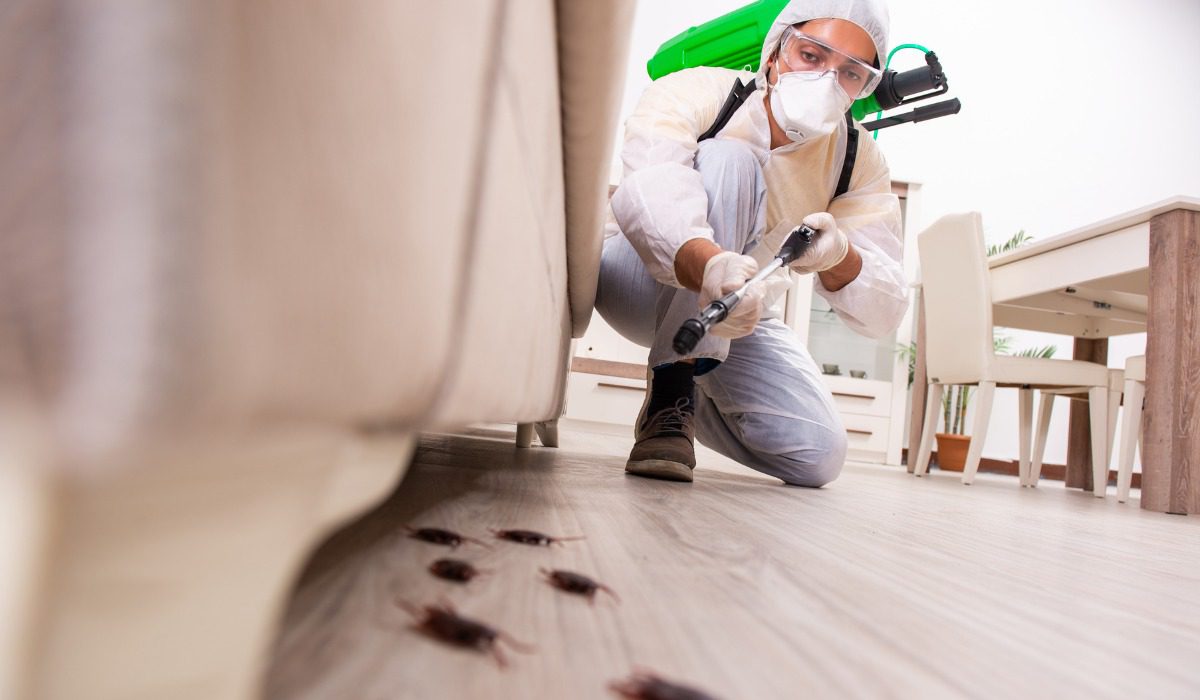Keeping your home free of pests is crucial for comfort, cleanliness and peace of mind. Pests not only damage property but also bring health risks. This article shares the best tips to control pests effectively. These simple strategies will protect your home, ensuring it’s clean and safe, giving you peace of mind.
See also: How to avoid pest infestation during monsoon season?
Importance of pest control
- Pests spread diseases like mosquitoes and rodents can carry harmful illnesses.
- Termites and rodents can damage homes by eating wood and chewing wires.
- Pests like dust mites and cockroaches can trigger allergies and asthma.
- Controlling pests improves indoor air quality and reduces allergy triggers.
- Pests can contaminate food with bacteria, leading to foodborne illnesses.
- Pest control protects our food supply and prevents illness.
- Dealing with pests can cause stress and anxiety.
- Effective pest control creates a more peaceful and enjoyable living environment.
- By reducing pesticide use, pest control helps protect wildlife.
- It also reduces pollution, making our environment cleaner.
Identifying common pests
- Ants: Ants come in different types, some like sugar, others prefer grease or protein. Look for lines of ants near food and nests inside or outside.
- Cockroaches: These insects are active at night and can survive tough conditions. They can trigger allergies and spread germs through their droppings. Find them in dark, damp places like kitchens and bathrooms.
- Rodents: Mice and rats can fit through tiny holes and chew on wires and furniture. They spread diseases through their droppings and urine.
- Termites: These bugs eat wood and can damage buildings silently. Look for mud tubes on walls, sagging floors and discarded wings near windows.
- Bed Bugs: These flat insects feed on human blood at night, causing itchy bites. Check for blood spots on bedding and bugs in mattress seams.
- Mosquitoes: Known for itchy bites, mosquitoes can carry diseases like West Nile virus. They breed in still water and are active at dawn and dusk.
Health hazards posed by pests
Pests pose health risks through disease transmission and bites. Ticks can transmit Lyme disease, while rodents and cockroaches are associated with salmonella. Mosquitoes carry diseases like West Nile virus. Their droppings and shed skin can trigger allergies and worsen asthma. Bites from mosquitoes, bed bugs and certain ants can cause itching and pain, with severe reactions sometimes becoming life-threatening.
Types of property damage caused by pests
Rodents and termites can cause significant structural damage by chewing through wood in buildings. Rodents and cockroaches contaminate food and surfaces with bacteria through their droppings and body parts, posing health risks. Rodents also pose electrical hazards by gnawing on wires, potentially leading to fires. A visible pest infestation can notably reduce the value of a property due to the perceived risks and damage caused by pests.
Read also: How to control pests in your kitchen?
Preventative measures
To prevent pests from invading your home, you can take simple steps in two main areas: home upkeep and cleanliness.
Home upkeep
- Seal cracks and gaps: Use caulk or weather stripping to seal cracks around windows, doors and pipes. Pests like ants and mice can squeeze through even tiny openings.
- Fix leaks and damp areas: Repair leaky pipes and faucets promptly to eliminate moisture that attracts pests. For example, mosquitoes and roaches thrive in damp places.
- Proper waste disposal: Use trash cans with lids that close tightly to keep pests out. Empty them regularly, especially kitchen bins where food scraps can attract pests. Outdoor compost piles should also be well-maintained.
Cleanliness and hygiene
- Regular cleaning: Develop a routine to wipe down surfaces, vacuum floors and take out the trash often. Crumbs and spills in areas like kitchens are magnets for pests.
- Store food properly: Keep food in sealed containers to prevent pests from sniffing out snacks. For instance, cereals and sugar should be in airtight bins.
- Manage pet areas: Store pet food in sealed containers and clean their bowls frequently to avoid attracting pests. Dispose of pet waste promptly and properly to deter flies and rodents.
Natural and DIY pest control methods
While professional pest control works well, you can try natural and DIY methods for common household pests. These are safer, especially if you have kids or pets. Keep in mind, their effectiveness can vary depending on how bad the pest problem is.
Natural repellents
- Essential oils: Some oils like peppermint and eucalyptus repel insects like ants and roaches. Mix a few drops with water in a spray bottle and spritz it around doors or where pests are seen.
- Diatomaceous earth (DE): This powder dries out insects. Sprinkle it where pests appear or create a barrier. Wear a mask because it can irritate your lungs.
- Vinegar and lemon: Mix vinegar or lemon juice with water to deter ants and roaches. Spray it near their trails or entry points.
DIY traps and solutions
- Ant traps: Mix borax with sugar and water. Ants are attracted to the sweet mix, but borax kills them. Place it away from kids and pets.
- Fly traps: Make a trap with a plastic bottle filled with sugar water. Flies go in but can’t get out. Hang pouches with dried cloves or lavender near doors.
- Rodent repellents: Rodents dislike strong smells. Soak cotton balls in peppermint oil or vinegar and place them where rodents might enter. Sachets with mint or cayenne pepper can also help.
Chemical and professional pest control
When dealing with persistent pest problems or needing a targeted approach, chemical solutions and professional pest control services are helpful.
Over-the-counter solutions
- Insecticides and sprays: These products target specific pests like ants, roaches, or mosquitoes. Follow safety instructions carefully. They’re good for small infestations, but watch out for risks to kids, pets and beneficial insects.
- Rodent baits and traps: Baits contain poisons that slowly kill rodents outside your home. Traps come in types like snap traps or glue traps. Place them carefully to avoid harming children or pets.
When to call a professional
- Severe infestation signs: If you notice lots of pests, lots of droppings, or damage from pests, it’s likely severe. Pros can handle tough cases.
- Benefits of professionals: They have expertise, stronger products and can tailor treatments. They seal entry points and suggest ways to prevent future problems.
- Choosing a company: Get quotes from several trusted companies. Ask about their experience, products used and if they’re licensed and insured. Look for guarantees on their work.
Seasonal pest control tips
Spring and summer
-
- Managing increased pest activity: Warmer temperatures in spring and summer mean more pests like insects and rodents. Check for signs such as droppings or trails, especially in areas with food or moisture. Seal cracks around doors, windows and foundations to keep pests out.
- Protecting outdoor space: Cut bushes and trees back from your home to remove hiding spots for pests and prevent them from getting inside. Use sealed bins to keep pests away from food scraps. Properly maintain compost piles to avoid attracting scavengers. Remove stagnant water sources like clogged gutters or bird baths to reduce mosquito breeding areas.
Fall and winter
- Preventing indoor refuge: As temperatures drop, pests seek warmth indoors. Seal cracks and gaps in your home’s structure to block entry points. Repair damaged screens on doors and windows to keep pests out.
- Seasonal maintenance tips: Clear leaves and debris from around your home’s foundation to eliminate hiding spots for pests. Keep firewood stored away from your house to prevent pests like termites or spiders from nesting in it.
Long-term pest prevention strategies
- Maintain your garden: Keep your garden tidy by removing weeds, fallen leaves and debris that can shelter pests. Overgrown plants near your home can create pathways for pests to get inside.
- Proper drainage and waste management: Prevent moisture buildup around your home by maintaining proper drainage. Pests like roaches are attracted to damp areas. Use sealed bins and dispose of waste regularly. Keep compost piles well-maintained and away from your house.
- Minimize hiding spots: Store firewood away from your home and keep outdoor furniture away from walls to reduce hiding places for pests.
- Natural deterrents: Plant herbs and flowers like mint, lavender, or citronella that naturally repel pests.
- Schedule pest inspections: Have a pest control professional inspect annually, especially before pest seasons. Early detection helps prevent big problems.
FAQs
Look for signs like live insects, droppings, shed skin, or trails. Rodents might leave gnaw marks or damage.
Expertise, targeted treatment plans, access to stronger products, sealing entry points and preventative advice.
Get quotes from reputable companies, ask about experience with your specific pest and check licensing and insurance.
Sealing cracks and gaps, repairing damaged screens, fixing leaks and addressing areas of dampness.
Yes! By taking preventative measures and maintaining a clean and healthy environment, you can significantly reduce the risk of pest infestations in your home. How can I identify a pest infestation?
What are the benefits of professional pest control?
How do I choose a pest control company?
What are some important home maintenance tasks for pest control?
Is prevention the best approach to pest control?
| Got any questions or point of view on our article? We would love to hear from you. Write to our Editor-in-Chief Jhumur Ghosh at jhumur.ghosh1@housing.com |







